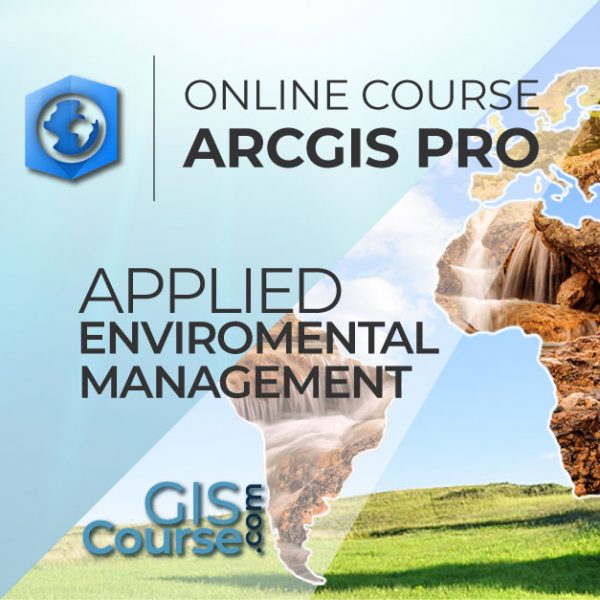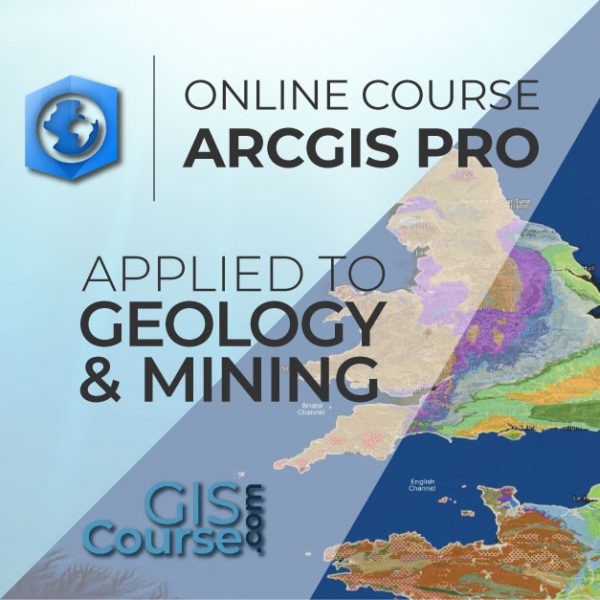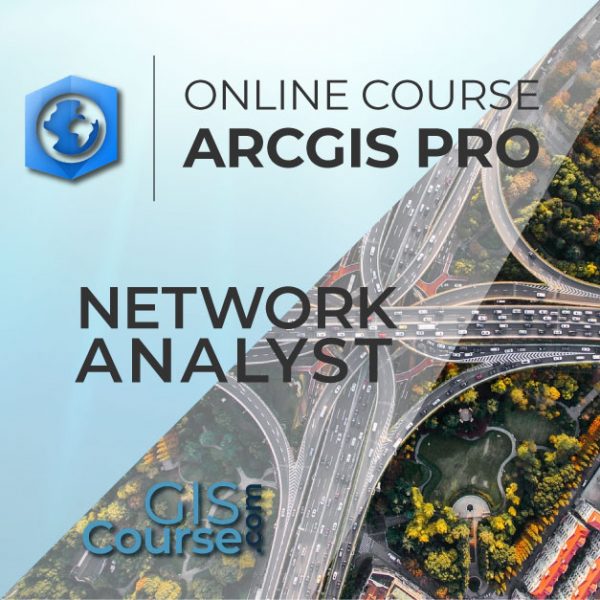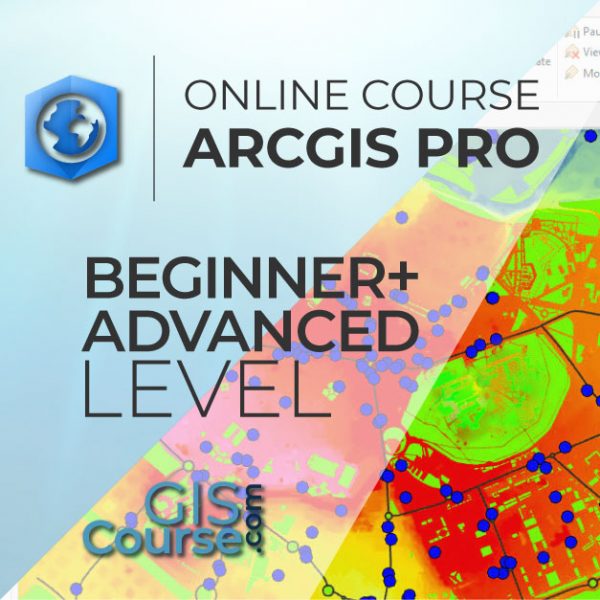ARCGIS PRO COURSE, FROM BEGINNER TO ADVANCED
ONLINE TRAINING
START DATE: 20TH OF FEBRUARY | 29TH OF JUNE (140 hours)
PRICE: 400€ (Standard fee) | 360€ (Student / Unemployed fee)
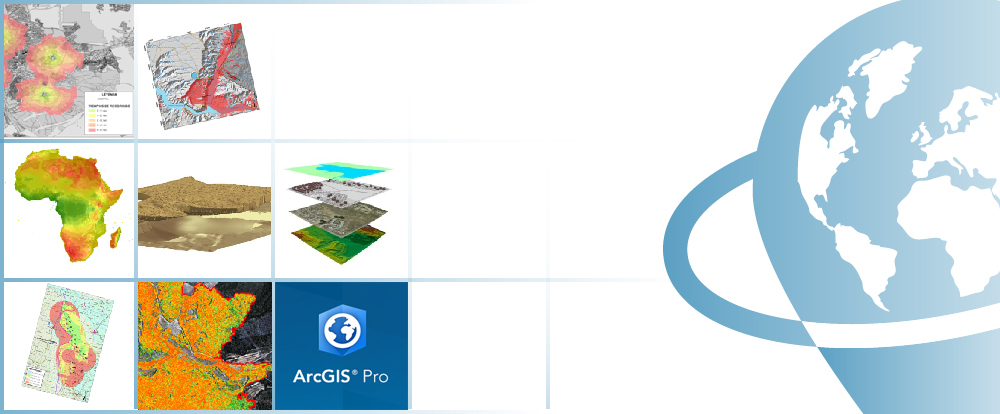
This course will qualify students in ArcGIS PRO, beginning with basic operations using vector and raster data models, creating basic maps/layouts, and progressing to complex spatial analysis using Spatial Analyst and 3D Analyst tools, topological corrections of layers in a geodatabase, task automation using ModelBuilder, and route analysis with Network Analysis, among other things.
Students will be trained in the creation and editing of vector and raster data, the use of basic greoprocessing tools available in ArcGIS PRO, the management and possible relationships between layers within a geodatabase, the use of topology to correct layers, advanced multi-criteria analysis, and network analysis such as finding the best routes and best times. The course also provides useful information for the creation of high-quality mapping products.
Students who register for this online course will have access to our virtual e-learning platform (which is available 24 hours). Here, they will find the course content, the practical and evaluation exercises, the forum discussion, and much more. One of the benefits of this course is that students can receive real-time support and assistance from the instructor whenever needed. The support for course-related issues is provided via direct messages and forum discussions on the platform, as well as via email or online meetings.
- Emphasize the significance and utility of a Geographic Information System (GIS), as well as its integration and applicability in a wide range of professional sectors.
- A general overview of the key GIS concepts and the fundamental skills required to use ArcGIS PRO.
- Learn about GIS key tools in an appropriate and professional manner, including the use of vector and raster data information to develop various operations and spatial analysis.
- Discover all of the potential problems that may arise during the execution of GIS projects, as well as their solutions, through hands-on exercises.
- Gain experience in data preparation, layout development, map creation, and the delivery of high-quality products.
- Learn about ModelBuilder, which can be used to create complex tools, connect them, and automate workflows.
- Learn about the benefits of a geodatabase, such as the possibility of topological correction of vector layers, network analysis (capabilities of finding optimal routes, accessibility studies, and so on).
- Develop your skills and gain experience in data preparation, layout development, map creation, and much more.
PART I. BEGINNER LEVEL
1 - INTRODUCTION TO GEOGRAPHIC INFORMATION SYSTEMS
- Introduction.
- Definition and basic concepts.
- Uses of Geographic Information Systems.
- Geographic information: vector data models, raster data models and other data models (CAD, TIN, etc.). Main features of each data module, advantages and disadvantages.
- Introduction to ArcGIS Desktop: ArcMap, ArCatalog, ArcToolbox, ArcScene and ArcGlobe.
- Arcmap interface, extensions and tools.
Guided exercise: Verify the software functionality.
2 - VECTOR DATA MODEL. INFORMATION DISPLAY
- Information layers: how to add layers, features and attribute tables.
- Data tools: search and queries.
- Selection tools: selection per feature, selection by spatial location and capture information.
- Layer symbology: basic symbology, by category, by quantity and through graphics.
- Other display options: labelling and transparencies.
Guided exercise: (load layers, types of selection, symbology) and assessment.
3 - COORDINATE SYSTEMS, PROJECTIONS AND GEOREFERENCING
- Introduction to Coordinate systems and projections.
- Defining Coordinate Systems.
- Coordinate system transformation. Reprojection of ED50 or ETRS89 geographic databases.
- Image, layer and CAD files georeferencing.
Guided exercise: (define, project, image georeferencing and CAD) and assessment.
4 - VECTOR DATA MODEL. EDITING AND CREATING INFORMATION
- Creation and editing of spatial data
– Creating of spatial data: Editing tools bar. Digitization techniques
– Exporting and importing spatial information files from different formats (CAD, DGN, Shp, ASCII, etc.). Create layers from CAD files
– Modifying existing layers
– Creating layers from coordinates. - Creation and editing of data in Attribute tables
– Structure of an Attribute table
– Types of data included in an attribute table
– Modify information from an attribute table
– Calculate geometric information (Surface, perimeter, length, etc.)
– Creation of statistics from an Attribute table
– Export tables to Excel and other formats. Report and graph creation.
Guided exercise: (create layers, digitize, modify attribute tables, add fields, geometric calculations, field calculator) and assessment.
5 - DATABASE MANAGEMENT
- Designing databases.
- Joining and relating databases.
- Spatial joins. Obtain statistics from database information and spatial position of elements in a layer.
Guided exercise: (join database and spatial relations) and assessment.
6 - SPATIAL ANALYSIS. MOST COMMON GEOPREOCESSING TOOLS.
- Extract Toolset (Clip, Split).
- Overlay toolset (intersect, union).
- Proximity toolset (buffer analysis, Thiessen polygons).
- Multi-criteria analysis. Obtaining optimum areas according to several criteria.
Guided exercise: (spatial analysis) and assessment.
7 - MAP CREATION
- Adjusting the size and type of sheet.
- Inserting elements: north, scale bar, numeric scale, map legend.
- Including other elements: images, graphs and tables.
- Adding several data frameworks
- Creation and use of templates.
- Printing options
Guided exercise: Creation of a map.
PART II. ADVANCED LEVEL
1 - INTRODUCTION TO RASTER DATA MODELS
- Introduction.
- Definition and basic concepts.
- Purposes and uses.
2 - BASIC OPERATIONS WITH RASTER DATA MODELS
- File conversion
– Converting files from vector to raster, and vice versa
– Converting ASCII or html files to raster
– Converting vector files to TIN
– Converting TIN to Raster formats
– Exporting files to KML (Google Earth) and CAD
– Creating Digital Elevation Models from vector data, ASCII and TIN files. - Extracting information from raster files
– By query
– By mask or entity - Joining raster files
Practical exercise: (convert files, create digital elevation models) and assessment.
3 - 2D AND 3D SPATIAL ANALYSIS
- Raster files reclassification. Building Boolean layers, adding values to intervals or categories, and data conversion.
- Grouping several raster layers. Algebra map, math calculations between raster layers, field statistics.
- Data interpolation. Exploring different interpolation tools (IDW, Kriging, Natural neighbor).
- Euclidean distances.
- Surface: contour, slope calculation, hillshade, orientation and visibility.
- Use in hydrology: obtaining a drainage system, flow direction, outlets, and identification of drainage basins or sub-basins.
- Volume calculation.
- Raster multi-criteria analysis: Basic concept and weighting.
- Least-cost routes.
Practical exercise: Interpolation of radiation data, volume calculations, complex multi-criteria analysis and least-cost route calculation.
4 - 3D DATA DISPLAY (ARCSCENE)
- Converting vector files from 2D to 3D.
- Vector and raster layers display in 3D.
- Virtual flights.
Practical exercise: Visibility of fire protection towers, volume of soil extracted from a quarry and 3D representation.
5 - MODEL BUILDER
- Use.
- Linking geoprocessing models using ModelBuilder.
- Creating custom tools using ArcToolBox.
Practical exercise: (creating geoprocessing models with ModelBuilder) and assessment.
6 - GEOSPATIAL DATABASE. GEODATABASE.
- Geodatabase: advantages. Properties.
- Loading data to the geodatabase.
- Domains and subtypes.
Practical exercise: (creating a geodatabase and its management) and assessment.
7 - TOPOLOGY
Massive correction of geospatial data errors.
- Topology considerations.
- Cluster tolerance.
- Most common rules in topology.
- Validating a topology.
- Topology errors.
- Management of errors.
Practical exercise: (error management and massive correction) and assessment.
8 - NETWORK ANALYST
- Definition
- Network categories
– Geometric networks
– Transportation networks - Network components
– Nodes
– Axis
– Flow - Creating network datasets
– Operators
– Optimal route
– Service areas
– Closest facility - Origin destination (OD) cost matrix.
Practical exercise: (creating a network dataset, route calculation, buffer areas) and assessment.

Catalin Cimpianu
With a Phd in Remote Sensing and GIS applied in hydrology and flood management, an MSc in Geomatics, and a BSc in Spatial Planning from Iasi, Romania’s “Alexandru Ioan Cuza” University, Catalin is a GIS consultancy professional and trainer at TYC GIS Soluciones Integrales.
He has over 6 years of experience with various geospatial software products (ArcGIS Desktop, QGIS), data collection, spatial analysis, geographical information manipulation, map creation, environmental consultancy, and other related subjects.
Why study Arcgis ArcGIS Pro?
The usage of Geographic Information Systems (GIS) is rapidly growing, becoming an essential tool in a variety of business sectors like engineering, environment, geography, mining or geomarketing.
Among GIS tools, ArcGIS is one of the most used GIS software worldwide, the most stable and versatile, comprised by a set of integrated applications, with a solid documentation over a wide range of tools being also supported by a large community.
ArcGIS provides contextual tools for data visualization, mapping and spatial analysis, connecting and combining information from varied sources (local and online), offering complex capabilities in order to explore, gain and enquire knowledge, that will lead to the best decisions. It can be also handled using a user interface as well as in command line using specific programming languages, like Python.
Do I need previous knowledge in ArcGIS Pro?
No, the training course starts from the very beginning.
I don’t have the ArcGIS Pro program. What can I do?
ArcGIS PRO software has a free trial license for a period of 21 days. You only need to create an account, download the program and follow the installation steps (see the website). However, we will assist you if you encounter any problem.
Moodle, the world’s most popular learning platform, is used to deliver our online courses. It is a highly adaptable Learning Management System that can be used to conduct and access courses, complete practical exercise tasks, interact with teaching staff in person, or benefit from support and resources at any time.
The online platform is available 24 hours a day, and the student can request assistance at any time. The instructors will serve as supervisors throughout the training process, assisting students with any difficulties they may encounter along the way.
The course is divided into modules, making it simple for students to find training material, download information, complete practical exercises, and take assessments to validate their newly acquired skills. The instructors will assist students throughout the course, providing progressive help and information based on their progress.
400€ (Standard fee) | 360€ (Student / Unemployed fee)
*To receive this discount, you must include a copy of a document proving your situation (student or unemployed).
** If you want to know the price in other currencies, use the online converter below: The Money Converter

First step. Fill out the registration form found below and email it to training@tycgis.com.

The second step. We will send you an enrollment guide with all of the information you need to finish the registration process. The enrollment guide will include details about the course’s content and structure, the time period it will run, and the software and licenses required. Payment methods will also be specified.

Step three. Complete the payment and email the receipt to training@tycgis.com.

Step four. We will confirm your registration to the course via email once we confirm the payment.

SPANISH INTERBANK TRANSFER:
ACCOUNT NUMBER: 0049 1809 222710347481 (Banco Santander)
BENEFICIARY: TYC GIS Soluciones Integrales SL
SUBJECT: “Student Name” and ARCGIS PRO BEGINNER TO ADVANCED LEVEL COURSE
INTERNATIONAL BANK TRANSFER:
BANK NAME: Banco Santander
BANK ADDRESS: Glorieta Ruiz Jiménez 1, 28015 Madrid (España).
BENEFICIARY: TYC GIS Soluciones Integrales SL
BENEFICIARY ADDRESS: Calle Fuencarral 158, Entreplanta, Oficina 16-17 28010 Madrid (España).
ACCOUNT NUMBER: ES90 0049 1809 222710347481
SWIFHT: BSCHESMM – IBAN: ES90
If you have difficulties in making the payment, contact training@tycgis.com




 (7 votes, average: 4.00 de 5)
(7 votes, average: 4.00 de 5)